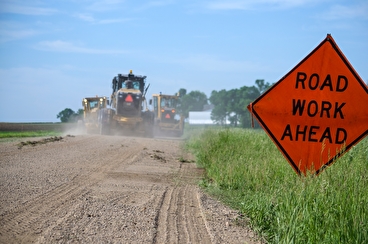
Gravel Road Maintenance: Meeting the Challenge offers instruction on proper gravel road maintenance techniques, either as a stand-alone tutorial or as an instructor’s tool to introduce the topics.
The toolkit consists of a 21-minute video and two instructional documents. It was produced by MnLTAP in 2006.
Outline
Each section of the outline below links directly to that portion of the video.
- Introduction: More than 50 percent of roads in America have a gravel surface, making them a critical part of our transportation system. Ken Skorseth, South Dakota LTAP field services manager, introduces the three most important topics of this toolkit for gravel road maintenance: safety, roadway shape, and a good surface gravel.
- Correct Roadway Shape: Correct roadway shape depends on maintaining a 4 percent slope, modifying the slope when the road intersects with another roadway, railroad crossing, or bridge, and fixing high shoulders.
- Shaping the Roadway: Shaping a gravel road with a motor grader involves several important steps: observe safety procedures, keep your motor grader in good condition, go slowly, pay attention to the angle and pitch of mold board, use the motor grader’s articulation and wheel lean, reshape roads in the spring, maintain shape throughout the year with light blading, blend material as you move it, and compact the surface with a roller to keep the material in place.
- Good Surface Gravel: About half of all problems on gravel roads are caused by poor gravel. Getting good surface gravel is about knowing what to look for, adopting specifications, and modifying the content of the gravel to get the best results.
- Dust Control: Good dust control is important is because it increases safety, saves money, pleases local residents, and reduces maintenance. Most agencies use chloride products to help control dust. Dust control works best with a 4 percent crown on the driving surface and good surface gravel.
Instructional Resources
- FHWA Gravel Roads Maintenance and Design Manual (PDF)
- Gravel Road Maintenance Instructor's Guide (PDF)
- Download the full Gravel Road Maintenance: Meeting the Challenge video (MP4)
- Minnesota users can request a copy of video on a DVD and printed copies of the instructional documents by emailing mnltap@umn.edu (For users in other states, please contact your state LTAP/TTAP center.)